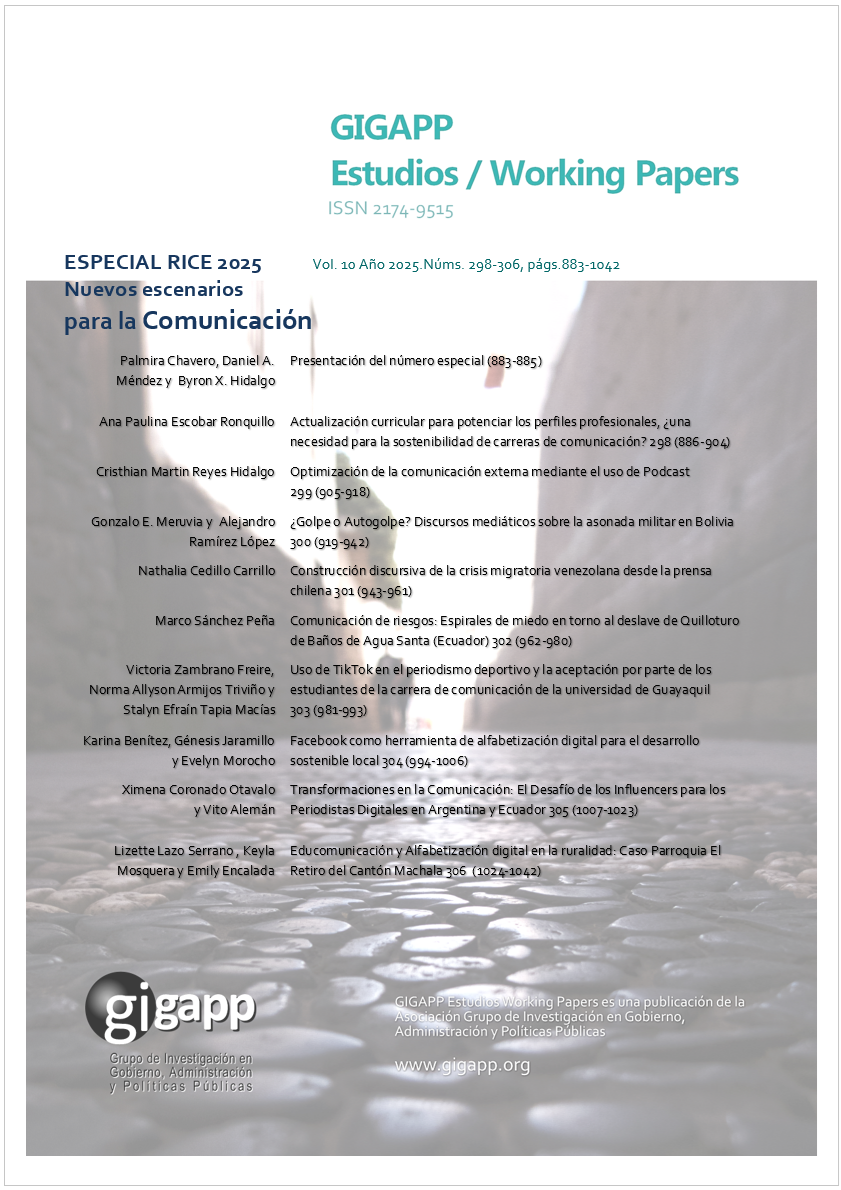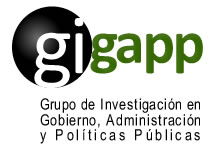Facebook como herramienta de alfabetización digital para el desarrollo sostenible local
Resumen
La investigación analizó el uso de Facebook como herramienta de alfabetización digital en comunicación ambiental para tres Gobiernos Autónomos Descentralizados (GAD) provinciales de Ecuador: El Oro, Carchi y Pastaza. El objetivo de la investigación fue identificar las potencialidades y limitaciones de esta red social en la promoción de la gestión ambiental de esas organizaciones. Con una metodología mixta que incluyó técnicas como el mapeo descriptivo, análisis de contenido con inteligencia artificial (IA) y entrevistas a expertos en comunicación y gestión ambiental, se analizaron las publicaciones realizadas en Facebook durante tres meses del 2023. Los resultados mostraron que las publicaciones sobre contenido ambiental fueron escasas y se priorizó lo estrictamente informativo sobre eventos temáticos, con variaciones en el formato entre las publicaciones de los tres organismos públicos provinciales. El GAD de El Oro se destacó por tener el mayor número de seguidores y publicaciones, mientras que los GADs de Carchi y Pastaza presentaron menor actividad. Sin embargo, en general, las publicaciones carecen de estrategias que promuevan la interacción y participación ciudadana, limitando su efectividad. El estudio concluye que, aunque Facebook es una plataforma accesible, no ha sido utilizada de manera óptima como herramienta de alfabetización digital para desarrollar comunicación pública que promueva desarrollo sostenible en esas regiones y que fomente mayor participación ciudadana en la gestión ambiental local, a través de las redes sociales.
Descargas
Citas
Agencia de Protección Ambiental de Estados Unidos. (noviembre de 2022). La importancia de la educación ambiental. Obtenido de https://espanol.epa.gov/espanol/la-importancia-de-la-educacion-ambiental
Alvino, C. (mayo de 2021). Estadísticas de la situación digital de Ecuador en el 2020-2021. Obtenido de https://branch.com.co/marketing-digital/estadisticas-de-la-situacion-digital-de-ecuador-en-el-2020-2021/
Anampi, C., Aguilar, E., Costilla, P., & Bohórquez, M. (septiembre de 2018). Gestión ambiental en las organizaciones: análisis desde los costos ambientales. Obtenido de https://www.redalyc.org/journal/290/29058776009/html/
Ávila, J. (2013). Redes sociales y análisis de redes. Obtenido de Aplicaciones en el contexto comunitario y virtual
Batallas, H. (2013). El actual modelo de descentralización en el Ecuador: un desafío para los gobiernos autónomos descentralizados. Obtenido de https://repositorio.uasb.edu.ec/bitstream/10644/4225/1/03-TC-Batallas.pdf
Carchi Prefectura. (2016). Datos Informativos de la Provincia del Carchi. Obtenido de https://www.carchi.gob.ec/2016f/index.php/informacion-provincial.html
Carrillo, D. (2016). El rol del gobierno central frente a la competencia exclusiva de uso y ocupación de suelo de los gobiernos autónomos descentralizados municipales. Obtenido de https://repositorio.uasb.edu.ec/bitstream/10644/5143/1/T2043-MDA-Carrillo-El%20rol.pdf
Consejo Nacional para la Igualdad de Género. (2021). POBLACIÓN DEL ECUADOR, SEGÚN PROVINCIA. Obtenido de https://www.igualdadgenero.gob.ec/wp-content/uploads/downloads/2021/09/POBLACION-DEL-ECUADOR-SEGUN-PROVINCIA.pdf
Constitución de la República del Ecuador. (2008). Obtenido de https://www.oas.org/juridico/pdfs/mesicic4_ecu_const.pdf
Contenidos. (2022). Los principios de la Comunicación Ambiental. Obtenido de https://www.cincovientos.com/principios-de-la-comunicacion-ambiental/
COOTAD. (31 de diciembre de 2019). CODIGO ORGANICO DE ORGANIZACION TERRITORIAL, COOTAD. Obtenido de https://www.cpccs.gob.ec/wp-content/uploads/2020/01/cootad.pdf
Dávalos, N. (marzo de 2020). 13 millones de personas tienen redes sociales en Ecuador. Obtenido de Primicias: https://www.primicias.ec/noticias/tecnologia/13-millones-personas-redes-sociales-ecuador/
De la Fuente, L. (2015). Redes sociales para organizaciones: una guía básica. Obtenido de https://biblioteca.clacso.edu.ar/Argentina/unlar/20171117044954/pdf_1512.pdf
Editorial Etecé. (2022). Cuadro comparativo. Obtenido de https://concepto.de/cuadro-comparativo/
El Universo. (Julio de 2023). Twitter, TikTok y Facebook son las redes sociales con mayores porcentajes de crecimiento en número de usuarios en Ecuador. Obtenido de https://www.eluniverso.com/noticias/informes/twitter-tiktok-y-facebook-son-las-redes-sociales-con-mayores-porcentajes-de-crecimiento-en-numero-de-usuarios-en-ecuador-nota/
Emagister. (4 de marzo de 2021). Importancia de la comunicación digital hoy. Obtenido de https://www.emagister.com/blog/importancia-de-la-comunicacion-digital-en-la-actualidad/
Enríquez, F. (2017). GOBIERNOS INTERMEDIOS: ENTRE LO LOCAL Y LO NACIONAL. Obtenido de https://biblio.flacsoandes.edu.ec/libros/digital/57072.pdf
Espinel, M. (2022). LA RESPONSABILIDAD SOCIAL CORPORATIVA.
Euroinnova. (2023). Aprende qué es el cuestionario en una investigación. Obtenido de https://www.euroinnova.ec/blog/que-es-el-cuestionario-en-una-investigacion
Euroinnova. (2023). Que es el método de mapeo. Obtenido de https://www.euroinnova.edu.es/blog/que-es-el-metodo-de-mapeo
Fernández, A. (26 de octubre de 2022). Las Redes Sociales más utilizadas: cifras y estadísticas. Obtenido de https://www.iebschool.com/blog/medios-sociales-mas-utilizadas-redes-sociales/
Folgueiras, P. (2016). La entrevista. Obtenido de https://diposit.ub.edu/dspace/bitstream/2445/99003/1/entrevista%20pf.pdf
Gobierno Autónomo Descentralizado Provincial de El Oro. (2019). El Oro Prefectura Misión. Obtenido de https://www.eloro.gob.ec/mision
Gobierno Provincial de Pastaza. (septiembre de 2019). INFORMACIÓN DE LA PROVINCIA DE PASTAZA. Obtenido de https://pastaza.gob.ec/pastaza/informacion/informacion-de-la-provincia-de-pastaza/
Gómez, Á. (2018). ¿QUÉ ES Y PARA QUÉ SIRVE EL MUESTREO ESTADÍSTICO? Obtenido de https://isdfundacion.org/2018/10/10/que-es-y-para-que-sirve-el-muestreo-estadistico/
González, A. (2023). Facebook como herramienta de comunicación ambiental. Revista Latinoamericana de Comunicación.
Guest, A. (12 de diciembre de 2019). Redes sociales: qué son, cómo funcionan, qué tipos existen y cómo influyen en las estrategias de Marketing. Obtenido de Rockcontent: https://rockcontent.com/es/blog/que-son-las-redes-sociales/
Guevara, G., Verdesoto, A., & Castro, N. (2020). Metodologías de investigación educativa (descriptivas, experimentales, participativas, y de investigación-acción).
Hernández, R. (2017). METODOLOGÍA DE LA INVETSIGACIÓN. Obtenido de https://www.uca.ac.cr/wp-content/uploads/2017/10/Investigacion.pdf
Herrera, H. (2015). LAS REDES SOCIALES: UNA NUEVA HERRAMIENTA DE DIFUSIÓN. Obtenido de Reflexiones: https://www.redalyc.org/pdf/729/72923962008.pdf
Ivan. (2023). Redes sociales: verticales, horizontales y mixtas. Obtenido de https://www.atsys.es/blog/sabias-existen-diferentes-tipos-redes-sociales
Kadoch, L. (4 de enero de 2023). El propósito de las diferentes Redes Sociales. Obtenido de https://www.leonkadoch.net/redes-sociales-facebook-instagram-twitter/
LEY DE GESTION AMBIENTAL. (2004). LEY DE GESTION AMBIENTAL, CODIFICACION. Obtenido de Registro Oficial Suplemento 418 de 10-sep-2004: https://www.ambiente.gob.ec/wp-content/uploads/downloads/2012/09/LEY-DE-GESTION-AMBIENTAL.pdf
López, F. (2009). El análisis de contenido como método de investigación. Obtenido de https://rabida.uhu.es/dspace/bitstream/handle/10272/1912/b15150434.pdf
Malavé, E., & Fernández, M. (2020). Gestión ambiental de las empresas públicas y privadas en la ciudad de Guayaquil - Ecuador y su incidencia en el desarrollo sostenible. Obtenido de http://portal.amelica.org/ameli/jatsRepo/382/3821581012/html/
Martín, S. (12 de mayo de 2021). Redes sociales horizontales: ¿Cuáles son? Obtenido de https://mkparadise.com/redes-sociales-horizontales
Martín, S. (2021). Redes sociales verticales: qué son y para qué sirven. Obtenido de https://mkparadise.com/redes-sociales-verticales
Medina, R. (2022). Estadísticas de la situación Digital en Ecuador 2021-2022. Obtenido de https://branch.com.co/marketing-digital/estadisticas-de-la-situacion-digital-en-ecuador-2021-2022/
Ministerio de Economía y Finanzas. (2021). El Presupuesto General del Estado. Obtenido de https://www.finanzas.gob.ec/el-presupuesto-general-del-estado/
Moreno, E. (2013). EL UNIVERSO EN UNA INVESTIGACIÓN. Obtenido de https://tesis-investigacion-cientifica.blogspot.com/2013/08/que-es-el-universo.html#google_vignette
Mora, P. (2023). Redes Sociales y Gestión Ambiental: Desafíos en Ecuador. Revista Comunicación y Desarrollo.
Mota, D. (2023). INTELIGENCIA ARTIFICIAL Y COMUNICACIÓN POLÍTICA. Obtenido de https://library.fes.de/pdf-files/bueros/la-comunicacion/20623.pdf
Nohlen, D. (2020). EL MÉTODO COMPARATIVO. Obtenido de https://archivos.juridicas.unam.mx/www/bjv/libros/13/6180/5.pdf
Organización de las Naciones Unidas para la Alimentación y la Agricultura. (2023). El rol de los Gobiernos Municipales. Obtenido de https://www.fao.org/in-action/herramienta-administracion-tierras/modulo-3/marco-conceptual/rol-gobiernos-municipales/es/
Ortega, C. (2023). Investigación comparativa: Qué es y cómo llevarla a cabo. Obtenido de https://www.questionpro.com/blog/es/investigacion-comparativa/
Pérez, G. (2023). Beneficios de la Inteligencia Artificial en el Análisis de Datos. Obtenido de https://es.linkedin.com/pulse/beneficios-de-la-inteligencia-artificial-en-el-datos-p%C3%A9rez-le%C3%B3n-
Pindado, F. (2005). Gobierno local y participación ciudadana. Obtenido de https://journals.copmadrid.org/pi/archivos/93334.pdf
Portal de formación estadística. (2023). Análisis exploratorio de datos. Obtenido de https://www.jmp.com/es_co/statistics-knowledge-portal/exploratory-data-analysis.html
Prefectura del Carchi. (2022). LA INSTITUCIÓN. Obtenido de https://carchi.gob.ec/2016f/index.php/lotaip-2022/junio2022/itemlist/category/105-la-intitucion.html?start=28
Responsabilidad Social Empresarial y Sustentabilidad. (2023). Responsabilidad Social: qué es, definición, concepto y tipos. Obtenido de Responsabilidad Social Empresarial y Sustentabilidad
Rodríguez, C., & Díaz, L. (2023). Impacto de las redes sociales en la gestión ambiental: Un estudio en Ecuador. Revista Comunicación para el Desarrollo Sostenible.
Sampieri, R. (2017). METODOLOGÍA DE LA INVETSIGACIÓN. Obtenido de https://www.uca.ac.cr/wp-content/uploads/2017/10/Investigacion.pdf
Santos, D. (agosto de 2023). Los mejores días y horas para publicar en redes sociales. Obtenido de https://blog.hubspot.es/marketing/mejor-hora-para-publicar-en-redes-sociales
Secretaria de Estado de Digitalización e Inteligencia Artificial. (2021). Guía Práctica de Introducción al Análisis Exploratorio de Datos. Obtenido de https://datos.gob.es/es/documentacion/guia-practica-de-introduccion-al-analisis-exploratorio-de-datos
Zeler, I. (2017). FACEBOOK COMO INSTRUMENTO DE COMUNICACIÓN EN LAS EMPRESAS DE AMÉRICA LATINA. Obtenido de https://www.tesisenred.net/bitstream/handle/10803/462203/TESI.pdf?sequence=1
Calvo, S., Ferreras, J., y Rodrigo-Cano, D.(2020) La Educación Ambiental en las redes sociales: #EA26. Revista de Educación Ambiental y Sostenibilidad2(1), 1301. doi:10.25267/Rev_educ_ambient_sostenibilidad.2020.v2.i1.1301 https://revistas.uca.es/index.php/REAyS/article/view/5335/6082
Cruz-Piza, I. A., Montoya-Tello, M. O., & Quishpi-Rodríguez, J. C. (2020). Gobiernos autónomos descentralizados del Ecuador. Iustitia Socialis, 5(3), 264. https://doi.org/10.35381/racji.v5i3.1102
Derechos de autor 2025 Karina Benítez-Luzuriaga, Génesis Jaramillo Ayala, Evelyn Morocho Cusme (Autor/a)

Esta obra está bajo licencia internacional Creative Commons Reconocimiento-NoComercial-CompartirIgual 4.0.
Aquellos autores/as que tengan publicaciones con esta revista, aceptan los términos siguientes:
a. Los autores/as conservarán sus derechos de autor y garantizarán a la revista el derecho de primera publicación de su obra, el cuál estará simultáneamente sujeto a la Licencia de reconocimiento de Creative Commons Attribution-NonCommercial-ShareAlike 4.0 International (CC BY-NC-SA 4.0) que permite a terceros compartir la obra siempre que se indique su autor y su primera publicación esta revista.
Con esta licencia de acceso abierto, los lectores (usuarios) pueden:
- Compartir — copiar y redistribuir el material en cualquier medio o formato
- Adaptar — remezclar, transformar y construir a partir del material
Bajo los siguientes términos:
-
Atribución — usarios deberán dar crédito de manera adecuada, brindar un enlace a la licencia, e indicar si se han realizado cambios. Puede hacerlo en cualquier forma razonable, pero no de forma tal que sugiera que usted o su uso tienen el apoyo de la licenciante.
-
NoComercial — usuarios no puede hacer uso del material con propósitos comerciales.
-
CompartirIgual — Si remezcla, transforma o crea a partir del material, usuarios deben distribuir su contribución bajo la misma licencia del original.
-
Sin restricciones adicionales: los usuarios no pueden aplicar términos legales o medidas tecnológicas que restrinjan legalmente a otros de hacer cualquier cosa que permita la licencia.
b. Los autores/as podrán adoptar otros acuerdos de licencia no exclusiva de distribución de la versión de la obra publicada (p. ej.: depositarla en un archivo telemático institucional o publicarla en un volumen monográfico) siempre que se indique la publicación inicial en esta revista
c. Se permite y recomienda a los autores/as difundir su obra a través de Internet (p. ej.: en archivos telemáticos institucionales o en su página web) antes y durante el proceso de envío, lo cual puede producir intercambios interesantes y aumentar las citas de la obra publicada. (Véase El efecto del acceso abierto).



